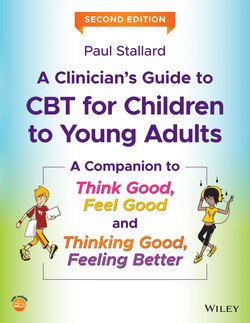Читать книгу A Clinician's Guide to CBT for Children to Young Adults - Paul Stallard - Страница 13
CBT as an intervention
ОглавлениеCBT has been well evaluated and has established itself as the most extensively researched of all the child psychotherapies (Graham 2005). Systematic reviews consistently demonstrate that CBT is effective for the treatment of a range of emotional problems in children, adolescents, and young people, including post‐traumatic stress disorder (PTSD; Gutermann et al. 2016; Morina et al. 2016; Smith et al. 2019); anxiety (Bennett et al. 2016; James et al. 2015); depression (Oud et al. 2019; Zhou et al. 2015), and obsessive‐compulsive disorder (OCD; Öst at al. 2016). Research is beginning to document the benefits of third wave CBT interventions such as mindfulness (Dunning et al. 2019; Klingbeil et al. 2017), dialectical behaviour therapy (McCauley et al. 2018), and acceptance and commitment therapy (Hancock et al. 2018).
Brief models of CBT, such as single‐session exposure therapy for the treatment of specific phobias, have been found to be highly effective (Öst & Ollendick 2017). Similarly, brief parent‐guided CBT has been found to be effective in the treatment of anxiety disorders (Cartwright‐Hatton et al. 2011; Creswell et al. 2017). Finally, model‐specific interventions, such as cognitive therapy for social anxiety (Leigh & Clark 2018) or single‐session exposure therapy for specific phobias (Davis et al. 2019), have found encouraging results.
This substantial and consistent evidence has resulted in CBT being recommended by expert groups such as the UK National Institute for Health and Clinical Excellence and the American Academy of Child and Adolescent Psychiatry for the treatment of young people with emotional disorders including depression, OCD, PTSD, and anxiety. This growing evidence base has also promoted the development of national training programmes in CBT. In the UK, the successful Improving Access to Psychological Therapies (IAPT) programme has been extended to children and young people (Shafran et al. 2014).
